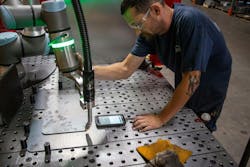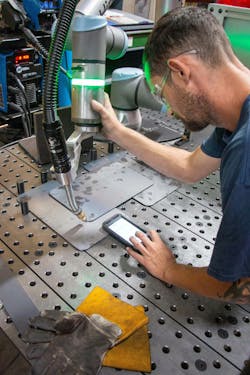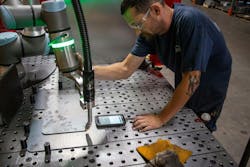With Software and Vision Systems Advances, Welding Cobots are Ready for Primetime
As we approach some of the industry’s premier trade shows for welding and manufacturing, including FABTECH in October, one question that is on everyone’s mind is, “What’s next for welding automation?” To shed light on the topic, AWS connected with Will Healy III, global industry manager—welding at Universal Robots.
UR is the industry’s leading provider of collaborative robots (cobots), has a worldwide installed base exceeding 75,000 arms and is the cobot provider of choice for many of the leading welding automation companies. Healy holds a B.S. in mechanical engineering from Purdue and has been involved with automation and industry for 20 years.
American Welding Society: What is the current state of automation within the welding industry?
Will Healy: Before drilling down, we need a quick recap of where we have been. As recently as two years ago, some welders were openly hostile and aggressive toward automation providers. They had this 1980s automotive industry mindset that robots were going to take their jobs. AWS’s WeldingWorkforceData.com says that we need to fill 82,500 jobs annually. Technology may impact the nature of your specific job—a theme I am going to come back to—but my gosh, the welding industry jobs are always going to be there.
READ MORE: A Business Case for Advanced Machine Vision in Factory Automation
AWS: What changed with automation?
WH: Automation is exponentially easier and more approachable than ever before for job shops. This is especially true due to recent advances in cobots. There has been a hyper-focus on simplifying the cobot integration experience and improving the cobot operator experience through intuitive interfaces.
As a result, a welder is now capable of operating multiple pieces of equipment, boosting machine utilization numbers and shortening changeover time between parts. With these factors, shops can now run more parts per machine with overnight runs or lights-out manufacturing, boosting shop competitiveness and helping leaders win new business.
AWS: What changed with welding operators?
WH: There are a couple of factors. Welders understand mechanical operations, and with a cobot, you grab the arm, put it where you want it and push a button to record a point on a weld path. This kind of touch-to-teach programming makes cobots approachable, especially for young folks that have always had a mobile phone. In fact, one cobot provider using our robots, Hirebotics, developed a cobot programming software app that runs on a tablet or smartphone. Anyway, young people believe in technology, so they are more receptive to tech that makes their job better and easier.
Older welders are realizing cobots extend their careers. In many cases, welding is physically tough, and those people eventually face a career shift. By becoming a cobot operator, they can keep welding or even enter a new career phase, such as supervising a group of cobot operators. I have had seriously tough guys get emotional to the point of tears when they realized cobots could extend their careers so they could put their kids through college, paying off their house or work to retirement age.
AWS: Automated welding has this reputation of sometimes missing the weld seam. What has been done to address that issue?
WH: You’re right. The joke has always been that you can’t weld air, which results from poor part fit-up. A couple of things have changed. First, people are getting smarter about which joints they automate. The bottom line: Automate the easy, boring, repeatable parts and save your skilled welders for the complex joints.
Second, more people need to understand a cobot is only part of the solution; repeatability requires a solid investment in tooling and fixturing. Third, integrators are getting better about assessing the real workflow. The classic case is where the operator has to pound on the part with a mallet to force it into a fixture. That’s not documented anywhere, so integrators need to analyze the entire workflow.
Finally, more people are getting smarter about feeding the robot consistent parts, such as by switching from less repeatable processes to laser cutting.
READ MORE: What Industries can Benefit from Machine Vision?
AWS: Are laser seam trackers an option for cobots?
WH: Yes, and companies such as Garmo Instruments make 2D laser seam trackers specifically for cobots. They have features such as:
- Vision programming, which means that the positioning of the torch during programming is calculated by the sensor, reducing the skill required.
- Seam finding: the sensor finds the right teach points of the welding joint before the weld in order to compensate the part deviation.
- Seam tracking: the programming of complex shapes is a consuming task. With the seam tracking solution, teaching the starting and the end point of the seam is made easier. The scanner scans four points of the piece and places it on the plane. The sensor then calculates the displacement and rotation offsets and applies them to the original program.
The seam tracker uses a Cat6e cable to connect to a PoE switch and then an Ethernet cable to the cobot. With URCap, our Java-based plugin that integrates into our graphical programming interface of Universal Robots, any integrator can easily create new, [user-friendly] programming screens.
AWS: What do advances in artificial intelligence and machine learning mean for cobots?
WH: How AI and robotics come together to create value for shops is the hot topic right now. UR has developed strategic partnerships with NVIDIA (a world leader in AI), Siemens (specifically the SIMATIC Robot Pick AI, a pre-trained, deep learning-based vision software) and Zivid Labs (which makes industrial 3D cameras). As a result, shops will be able to pick a wider variety of parts with unprecedented reliability.
READ MORE: Deep Learning Complements Machine Vision Solutions
Notice I said pick parts, which is an underappreciated side of cobots in the welding industry. Think of all the resistance welding operators who have the repetitive task of fishing two pieces of metal out of a bin and presenting them to the tongs. In the past, manual operators were needed because vision systems couldn’t reliably pick greasy, reflective parts.
Now with the sheer processing power available, the system can crunch millions of data points from the vision system as the robot arm approaches the part. Add in AI, and now it is possible to use cobots for a range of applications that were challenging to automate in the recent past.
AWS: What’s the next step for a welding company?
WH: Cobots were made for high-mix, low- to medium-volume applications, but for people new to automation, it can feel overwhelming to try to figure out that first cobot on your own. An easy step is to visit with automation providers at trade shows such as FABTECH where they can meet people with decades of shop automation experience and make valuable connections to potential partners in their automation journey.
Safety is always a top question when it comes to cobots. For safety resources, see AWS’s D16.1 Specification for Robotic Arc Welding Safety, AWS D16.3 Risk Assessment Guide for Robotic Arc Welding and additional robotic welding specifications.


